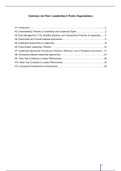Samenvatting
Samenvatting van Wart H1-10 15 van Publieke managers en leiderschap
- Instelling
- Erasmus Universiteit Rotterdam (EUR)
Deze uitgebreide samenvatting van Van Wart maakt het lange en moeilijke boek overzichtelijk. De theorieën worden zowel uitgelegd in woorden als toegelicht in het conceptuele model dat van Wart zelf gebruikt weergegeven, maar in betere taal. De hoofdstukken die worden samengevat zijn allemaal de le...
[Meer zien]





